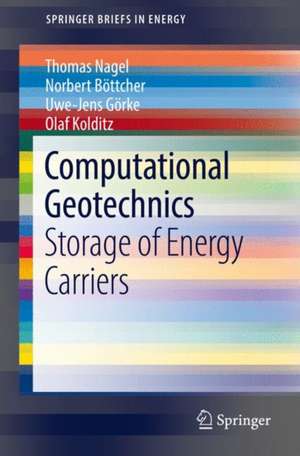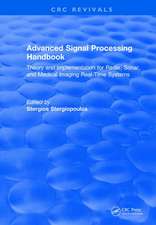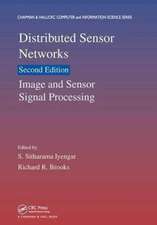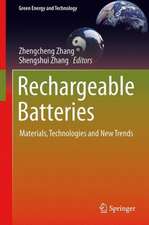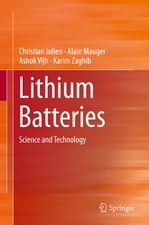Computational Geotechnics: Storage of Energy Carriers: SpringerBriefs in Energy
Autor Thomas Nagel, Norbert Böttcher, Uwe-Jens Görke, Olaf Kolditzen Limba Engleză Paperback – 5 mai 2017
Din seria SpringerBriefs in Energy
-
 Preț: 345.89 lei
Preț: 345.89 lei -
 Preț: 345.89 lei
Preț: 345.89 lei -
 Preț: 377.35 lei
Preț: 377.35 lei -
 Preț: 476.42 lei
Preț: 476.42 lei -
 Preț: 343.36 lei
Preț: 343.36 lei -
 Preț: 374.85 lei
Preț: 374.85 lei -
 Preț: 376.59 lei
Preț: 376.59 lei -
 Preț: 477.72 lei
Preț: 477.72 lei -
 Preț: 176.35 lei
Preț: 176.35 lei -
 Preț: 380.07 lei
Preț: 380.07 lei -
 Preț: 376.22 lei
Preț: 376.22 lei -
 Preț: 377.95 lei
Preț: 377.95 lei -
 Preț: 376.43 lei
Preț: 376.43 lei -
 Preț: 377.73 lei
Preț: 377.73 lei -
 Preț: 343.00 lei
Preț: 343.00 lei -
 Preț: 377.35 lei
Preț: 377.35 lei -
 Preț: 377.95 lei
Preț: 377.95 lei -
 Preț: 444.35 lei
Preț: 444.35 lei -
 Preț: 348.84 lei
Preț: 348.84 lei -
 Preț: 412.30 lei
Preț: 412.30 lei -
 Preț: 377.73 lei
Preț: 377.73 lei -
 Preț: 375.62 lei
Preț: 375.62 lei -
 Preț: 380.07 lei
Preț: 380.07 lei -
 Preț: 376.80 lei
Preț: 376.80 lei -
 Preț: 376.22 lei
Preț: 376.22 lei -
 Preț: 479.67 lei
Preț: 479.67 lei - 15%
 Preț: 463.85 lei
Preț: 463.85 lei -
 Preț: 476.79 lei
Preț: 476.79 lei -
 Preț: 375.23 lei
Preț: 375.23 lei -
 Preț: 379.09 lei
Preț: 379.09 lei -
 Preț: 376.22 lei
Preț: 376.22 lei -
 Preț: 409.43 lei
Preț: 409.43 lei - 15%
 Preț: 462.38 lei
Preț: 462.38 lei -
 Preț: 414.21 lei
Preț: 414.21 lei -
 Preț: 375.62 lei
Preț: 375.62 lei -
 Preț: 374.30 lei
Preț: 374.30 lei -
 Preț: 376.22 lei
Preț: 376.22 lei - 15%
 Preț: 463.35 lei
Preț: 463.35 lei -
 Preț: 381.72 lei
Preț: 381.72 lei -
 Preț: 379.09 lei
Preț: 379.09 lei -
 Preț: 375.62 lei
Preț: 375.62 lei - 15%
 Preț: 463.35 lei
Preț: 463.35 lei -
 Preț: 376.80 lei
Preț: 376.80 lei -
 Preț: 374.46 lei
Preț: 374.46 lei -
 Preț: 477.56 lei
Preț: 477.56 lei -
 Preț: 379.48 lei
Preț: 379.48 lei -
 Preț: 374.30 lei
Preț: 374.30 lei -
 Preț: 479.47 lei
Preț: 479.47 lei -
 Preț: 378.12 lei
Preț: 378.12 lei
Preț: 376.04 lei
Nou
Puncte Express: 564
Preț estimativ în valută:
71.98€ • 78.21$ • 60.50£
71.98€ • 78.21$ • 60.50£
Carte tipărită la comandă
Livrare economică 21 aprilie-05 mai
Preluare comenzi: 021 569.72.76
Specificații
ISBN-13: 9783319569604
ISBN-10: 3319569600
Pagini: 70
Ilustrații: XII, 70 p. 29 illus., 26 illus. in color.
Dimensiuni: 155 x 235 x 4 mm
Greutate: 0.13 kg
Ediția:1st ed. 2017
Editura: Springer International Publishing
Colecția Springer
Seriile SpringerBriefs in Energy, Computational Modeling of Energy Systems
Locul publicării:Cham, Switzerland
ISBN-10: 3319569600
Pagini: 70
Ilustrații: XII, 70 p. 29 illus., 26 illus. in color.
Dimensiuni: 155 x 235 x 4 mm
Greutate: 0.13 kg
Ediția:1st ed. 2017
Editura: Springer International Publishing
Colecția Springer
Seriile SpringerBriefs in Energy, Computational Modeling of Energy Systems
Locul publicării:Cham, Switzerland
Cuprins
Chapter1. Introduction.- Chapter2. Basics of thermomechanics and inelasticity.- Chapter3. Simulation of laboratory tests.- Chapter4. Simulating Gas Storage in Salt Caverns.- Chapter5. Closing remarks.
Recenzii
Notă biografică
Dr. Thomas Nagel leads the "Computational Energy Systems" research group in the Department of Environmental Informatics at the Helmholtz Centre for Environmental Research (UFZ). The Centre studies the complex interactions between humans and the environment in cultivated and damaged landscapes, especially densely populated urban and industrial areas and natural landscapes. The scientists and researchers who work in the Centre develop concepts and processes to help secure the natural foundations of life for future generations.
Textul de pe ultima copertă
In this book, effective computational methods to facilitate those pivotal simulations using open-source software are introduced and discussed with a special focus on the coupled thermo-mechanical behavior of the rock salt. A cohesive coverage of applying geotechnical modeling to the subsurface storage of hydrogen produced from renewable energy sources is accompanied by specific, reproducible example simulations to provide the reader with direct access to this fascinating and important field. Energy carriers such as natural gas, hydrogen, oil, and even compressed air can be stored in subsurface geological formations such as depleted oil or gas reservoirs, aquifers, and caverns in salt rock. Many challenges have arisen in the design, safety and environmental impact assessment of such systems, not the least of which is that large-scale experimentation is not a feasible option. Therefore, simulation techniques are central to the design and risk assessment of these and similar geotechnicalfacilities.
- Current research on applying geotechnical modeling to energy storage and dispatch for renewable energy systems;
- Discusses effective computational methods for conducting design and safety assessments of geotechnical facilities using open-source software;
- Demonstrates how computational simulations can be invaluable in scenarios where large-scale field experimentation is not possible.
Caracteristici
Current research on applying geotechnical modeling to energy storage and dispatch for renewable energy systems Discusses effective computational methods for conducting design and safety assessments of geotechnical facilities using open-source software Demonstrates how computational simulations can be invaluable in scenarios where large-scale field experimentation is not possible Includes supplementary material: sn.pub/extras Includes supplementary material: sn.pub/extras
